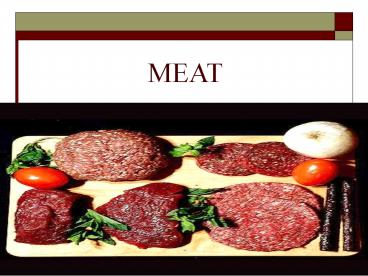MEAT PowerPoint PPT Presentation
Title: MEAT
1
MEAT
2
Structure
- Meat is the flesh of animals reared for food.
E.g. cows, goats, pigs. - Meat is composed of bundles of muscle fibres
joined by strong connective tissues with fat
scattered between. - The main protein in muscles is myosin and actin.
- Connective tissues contain the protein collagen
and elastin.
3
Types of Meat
- Beef Cow, cattle
- Mutton Goat, sheep
- Pork Pig
- Veal Calf
- Venison Deer
4
Offals
- edible internal organs of animals
- E.g. brain, kidney, heart, liver, tripe, tongue
- Very good source of
- iron and vitamin B12 (liver and kidney)
- Vitamin A (liver)
- Glycogen (liver)
5
Nutritive Value
- Protein Myosin, globulin collagen (in connective
tissue) - Fats particularly lamb, pork and beef, gives
flavour, moisture and texture. Some fats are
found between muscle fibre of lean parts of meat.
This is known as marbling. - Vitamins a good amount of B group vitamins
- Minerals A good amount of iron and phosphorus.
- Cholesterol
- Water - 60
6
Factors to consider when choosing meat
- Good characteristic colour
- No unpleasant smell
- Firm and elastic to touch, moist but not wet.
- Grain should be fine and even.
- Avoid too much bone, gristle or fat
7
What makes meat tough or tender?
- 1. Age
- In young animals, the muscle fibres are short and
finer. Meat is tender. - As the animal matures, the muscle fibre thickens
and there is more connective tissues. Thus the
meat from the older animals is tougher than the
meat from young animals. - There is also more fat in older animals.
8
What makes meat tough or tender?
- 2. Part of the animal
- Meat from the leg is usually tougher than meat
from the ribs because the leg muscles work
harder. - The more the animal works the muscle, and the
tougher it will be.
9
What makes meat tough or tender?
- 3. Fat distribution
- When fat is evenly distributed throughout
the muscle, the meat is usually more tender and
of a better flavour than meat that has
concentrated visible deposits of fats.
10
What makes meat tough or tender?
- 3. Fat distribution
11
Methods used to tenderize meat
- Mincing or grinding
- Cubing, slicing - Cut meat across the grains.
- Pounding with a meat pounder or the blunt edge of
a cleaver - Sprinkling with commercial tenderizer e.g. papain
(papaya) - Marinating e.g. Soya sauce, acids (lemon juice,
vinegar, tomato) yoghurt, wine. - Cooking slowly with water e.g. stewing, boiling.
(Collagen in the connective tissue changes into
gelatin which dissolves in the water. This causes
the meat to come apart easily.)
12
Reasons for cooking meat
- To kill any harmful bacteria
- To make it tender and more digestible
- To make it look, taste and smell more appetizing
- To preserve food for later use
- To develop extractives for flavour
13
Effect of heat
- Dry heat
- Protein starts to coagulate at 60C
- Red meat changes to brown
- Fats melts and goes crisp making meat juicy
- Meat shrinks as protein coagulates and shortens.
- - If meat is overcooked, juices are
squeezed out onto surface, which might then dry
out. - Connective tissues (containing collagen) becomes
tougher.
14
Effect of heat
- Dry heat cooking (roasting, baking,
grilling) is best for tender meat which has
little or no collagen and elastin. The elastin
will contract during cooking, squeezing out the
meat juices causing the meat to be dry.
15
Effect of heat
- Moist Heat
- Protein starts to coagulates at 60C when outer
layer is sealed lightly. - Red meat changes to grayish brown.
- Fat melts partly and seeps into the gravy.
- Meat shrinks a little. The longer the cooking,
the greater the shrinkage. Juices tend to come
out of the meat into the gravy, developing a rich
flavour in the gravy, with slight loss of flavour
of meat. - Collagen in connective tissue is converted to
gelatin. Overcooking results in the meat falling
apart.
16
Effect of heat
- Moist heat method (boiling, stewing,
frying) is recommended for cooking tough meat as
it is a slow process.
17
Which is more difficult to digest?
- Meat
- Or
- Fish
18
Meat is more difficult to digest than fish.
- Fish has no elastin (the wall of muscle fibre,
very tough, cannot be changed by cooking but can
be broken down mechanically or removed) - Fish consists of short, fine fibres, bound
together by a small amount of fine connective
tissue.
19
Ways to reduce fat content in meat
- Use more poultry, reduce consumption of red meat
- Avoid frying. Grill or bake instead
- Remove fat before cooking
20
Marbling of fats in beef

